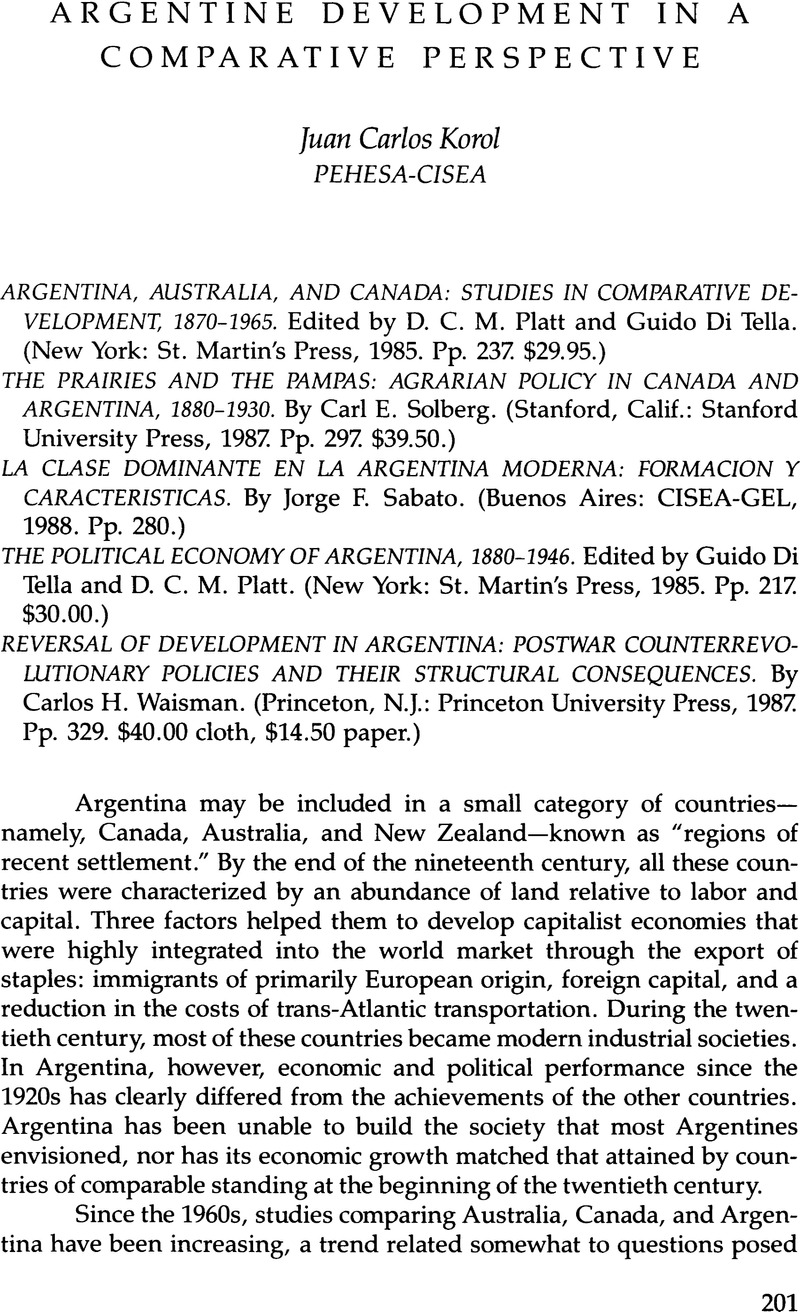Published online by Cambridge University Press: 12 October 2022

1. Some comparatives studies, particularly between Australia and Argentina, draw on a long tradition going back to the nineteenth century. Scholarly work on this subject has expanded since the 1960s. For a bibliography, see Tim Duncan and John Fogarty, Australia and Argentina: On Parallel Paths (Melbourne: Melbourne University Press, 1984); see also John Fogarty, Ezequiel Gallo, and Héctor Diéguez, Argentina y Australia (Buenos Aires: Instituto Torquato Di Telia, 1979).
2. Compare Guido Di Telia and Manuel Zimmerman, Las etapas del desarrollo económico argentino (Buenos Aires: Eudeba, 1967).
3. Compare Carlos F. Díaz Alejandro, Essays on the Economic History of the Argentine Republic (New Haven, Conn.: Yale University Press, 1970).
4. On Argentina's relationship with Great Britain and the United States, see, among others, H. S. Ferns, Britain and Argentina in the Nineteenth Century (Oxford: Clarendon Press, 1960); Jorge Fodor and Arturo O'Connell, “La Argentina y la economía atlántica en la primera mitad del siglo XX,” Desarrollo Económico 13, no. 49 (Apr.–June 1973):3–65; Carlos Escudé, Gran Bretaña, Estados Unidos y la declinación argentina, 1942–1949 (Buenos Aires: Editorial de Belgrano, 1983); and Mario Rapoport, Gran Bretaña, Estados Unidos y las clases dirigentes argentinas, 1940–1945 (Buenos Aires: Editorial de Belgrano, 1981). On the period of export-led growth, an especially relevant work is Roger Gravil, The Anglo-Argentine Connection, 1900–1939 (Boulder, Colo., and London: Westview, 1985).
5. On this point, see Vicente Vázquez-Presedo, El caso argentino: migración de factores, comercio exterior y desarrollo, 1875–1914 (Buenos Aires: Eudeba, 1971), 164–65. Vázquez-Presedo refers to 1909, Solberg to the 1920s. For an appraisal of the situation during the 1930s, see also Solberg's “Land Tenure and Land Settlement: Policy and Patterns in the Canadian Prairies and the Argentine Pampas, 1880–1930,” in Platt and Di Telia, Argentina, Australia, and Canada, 53–75.
6. For a recent assessment of Argentine agrarian expansion until the 1930s, compare Alfredo R. Pucciarelli, El capitalismo agrario pampeano, 1880–1930 (Buenos Aires: Hyspamérica, 1986); and Hilda Sabato, “La cuestión agraria pampeana: un debate inconcluso,” Desarrollo Económico 27, no. 106 (July–Sept. 1987):291–301.
7. For an example of a contrasting view, see the important article by Arturo O'Connell, “La Argentina en la depresión: los problemas de una economía abierta,” Desarrollo Económico 23, no. 92 (Jan.–Mar. 1984):479–514.
8. Compare Gravil, The Anglo-Argentine Connection, 1900–1939.
9. A bibliography is growing on Peronist economic policies. See, among others, Javier Villanueva, “Economic Development,” in Prologue to Perón: Argentina in Depression and War, 1930–1943, edited by Mark Falcoff and Ronald H. Dolkart (Berkeley and Los Angeles: University of California Press, 1976), 57–67; and Juan E. Corradi, The Fitful Republic: Economy, Society, and Politics in Argentina (Boulder, Colo.: Westview, 1985), 47–79.
10. For example, changes in oil policies were under heavy attack by the opposition to the government.
11. For a recent assessment of different explanations on the Argentine agricultural stagnation from 1944 to 1960, see Osvaldo Barsky, “Reflexiones sobre las interpretaciones de la caída y expansión de la agricultura pampeana,” in Osvaldo Barsky et al., La agricultura pampeana: transformaciones productivas y sociales (Buenos Aires: Fondo de Cultura Económica, Instituto Interamericano de Cooperación para la Agricultura, Centro de Investigaciones Sociales sobre el Estado y la Administración, 1988).
12. See, among others, David Rock, Argentina, 1516–1987: From Spanish Colonization to Alfonsín (Berkeley and Los Angeles: University of California Press, 1987), 327–70; and Duncan and Fogarty, Australia and Argentina: On Parallel Paths, 130.
13. See, among others, Jorge Schvarzer, La política económica de Martínez de Hoz (Buenos Aires: Hispamérica, 1986); Adolfo Canitrot, “La disciplina como objetivo de la política económica: un ensayo sobre el programa económico del gobierno argentino desde 1976,” Desarrollo Económico 19, no. 76 (Jan.–Mar.):453–76; and Bernardo Kosacoff and Daniel Azpiazu, La industria argentina: desarrollo y cambios estructurales (Buenos Aires: Centro Editor de América Latina, CEPAL, 1989).
14. Ezequiel Gallo, “El método comparativo en historia: Argentina y Australia (1850–1914),” in Fogarty, Gallo, and Diéguez, Argentina y Australia, 3–18.